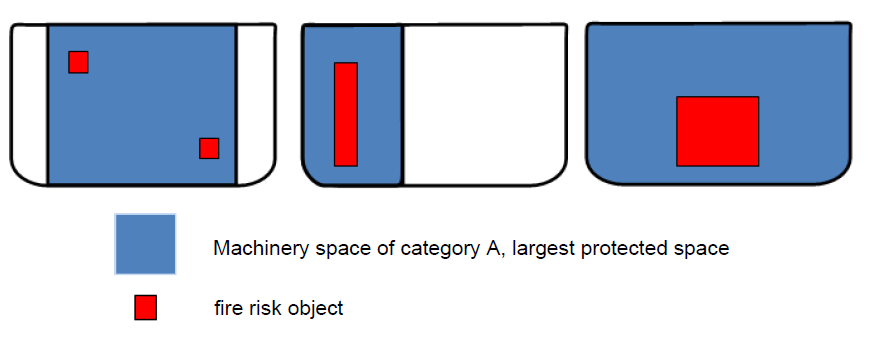CHAPTER 5 – FIXED GAS FIRE-EXTINGUISHING SYSTEMS
Fixed gas fire-extinguishing systems (paragraph 2.2.1.7)
1 The "quantity of gas" means that quantity required for the largest cargo space in
accordance with the provisions of paragraph 2.1.1.1 of chapter 5:
- "2.1.1.1 Where the quantity of the fire-extinguishing
medium is required to protect more than one space, the quantity of medium
available need not be more than the largest quantity required for any one
space so protected. ... Adjacent spaces with independent ventilation systems
not separated by at least A-0 class divisions should be considered as the
same space."
2 In such cases, the system controls should be capable of allowing one third, two
thirds or the entire quantity of gas as required by paragraph 2.1.1.1 of chapter 5
to be discharged to comply with the last sentence of paragraph 2.2.1.7 (i.e. the
number of setting points of control is three).
CHAPTER 6 – FIXED FOAM FIRE-EXTINGUISHING SYSTEMS
Foam-generating capacity of fixed foam fire-extinguishing systems (paragraphs
3.2.1.2 and 3.3.1.2, as amended by resolution MSC.327(90))
1 This interpretation of the term "largest protected space" applies to a machinery
space of category A protected by a fixed high-expansion foam fire-extinguishing
system complying with the provisions of the FSS
Code.
2 Where such a machinery space includes a casing (e.g. an engine casing in a
machinery space of category A containing internal combustion machinery, and/or a
boiler), the volume of such a casing, above the level up to which foam should be
filled to protect the highest position of the fire risk objects within the machinery
space, need not be included in the volume of the protected space (see figure 1).
3 The level up to which foam should be filled to protect the highest positioned fire
risk objects within the machinery space should not be less than:
whichever is higher (see figure 1).
4 Where such a machinery space does not include a casing, the volume of the largest
protected space should be that of the space in its entirety, irrespective of the
location of any fire risk object therein (see figure 2).
5 Fire risk objects include, but may not be limited to, those listed in SOLAS
regulation II-2/3.31 and those defined in regulation II-2/3.34. Although not referred to in those
regulations, they may also include items having a similar fire risk such as exhaust
gas boilers or oil fuel tanks.

Figure 1: Machinery space including a casing

Figure 2: Machinery space not including a casing
CHAPTER 9 – FIXED FIRE DETECTION AND FIRE ALARM SYSTEM
Additional indicating unit in the cargo control room (paragraph
2.5.1.3, as amended by resolution MSC.339(91))
A space in which a cargo control console is installed, but does not
serve as a dedicated cargo control room (e.g. ship's office, machinery control
room), should be regarded as a cargo control room for the purposes of paragraph
2.5.1.3 of chapter 9 of the FSS Code, as amended by resolution MSC.339(91), and therefore be provided with an
additional indicating unit.